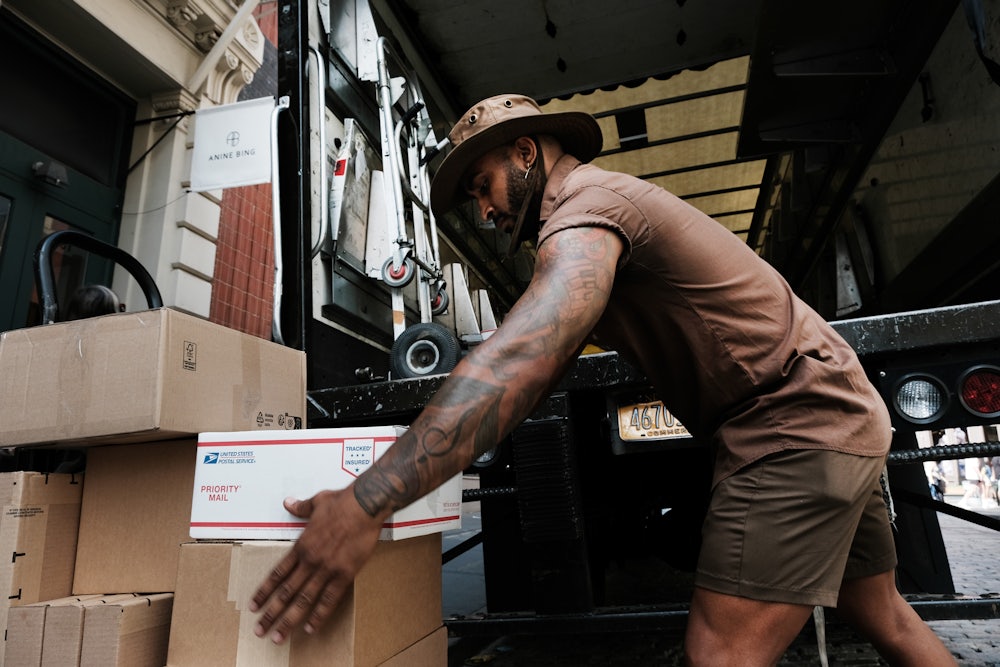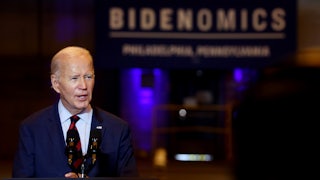After five decades of decline, America’s labor unions are showing some important signs of resurgence, most notably with unionization victories at Starbucks, Amazon, Trader Joe’s, REI, and Apple. In recent days, unions have continued their forward march with strikes by 6,000 Los Angeles hotel workers, 11,500 Hollywood writers, and 160,000 television and movie actors.
But what would be this year’s biggest moment for a labor resurgence might be just days away: 340,000 UPS workers are threatening to walk out on August 1, in what would be the nation’s largest strike in decades. In such a showdown, their union, the Teamsters, and its ambitious new president, Sean O’Brien, would face off against UPS, a $100 billion-a-year giant that handles one-fourth of the nation’s parcel business. (On Tuesday, after this article was published, the two sides announced a tentative agreement.)
O’Brien, a fourth-generation truck driver, realizes that a high-visibility strike that wins big gains would make a powerful statement that unions do deliver to their members and that organized labor might be on its way back. As was the case in 1997 when the Teamsters last struck UPS, a Teamsters walkout would send shock waves through the nation’s economy—UPS says 6 percent of the nation’s gross domestic product moves in its trucks. A strike would hurt millions of households and businesses, disrupting deliveries of medicines, birthday gifts, Amazon goods, and parts that factories need. By one estimate, a 10-day UPS strike would cost the U.S. economy more than $7 billion and be the costliest walkout in more than a century. That’s a big chunk of history, which covers such famous clashes as the 1981 air traffic controllers’ walkout and the 1936–37 Flint sit-down strike against General Motors.
O’Brien recently said a UPS walkout “appears inevitable,” suggesting an eagerness on his part to have the Teamsters’ rank and file go on strike. Not only would a walkout catapult him into national headlines and the front ranks of labor leaders, but it would make a powerful statement to an important group of workers O’Brien is keen to unionize: the hundreds of thousands of Amazon drivers and warehouse workers across the United States. A convincing victory over UPS would convey this message to Amazon workers: You should join the mighty Teamsters because we can deliver to you too.
For the Teamsters, unionizing Amazon is critical. Amazon’s nonunion operations, including its fast-expanding truck fleet, put downward pressure on Teamster wages. Moreover, unionizing many Amazon workers would swell the Teamsters’ ranks, which have shrunk to 1.2 million from a peak of two million in the 1970s. Discussing UPS last month, O’Brien said, “If we’re going to be successful in organizing Amazon, we need the best contract in the industry” at UPS.
Teamster leaders realize that it’s a good time to strike—Joe Biden and his administration are strongly pro-union, the extremely tight labor market gives unions extra leverage, many workers are fuming about how they were treated during the pandemic, and public approval of unions is at its highest level in six decades. Moreover, UPS’s soaring profits make the company a fat target; in his many speeches that seek to prepare UPS workers to strike, O’Brien loves to bash the company rhetorically. Its revenues have jumped 33 percent since 2019, while its net income has more than doubled, to $11.6 billion from $4.5 billion.
It would be very wrong, however, to think that a strike would be just about ambition and making a statement. UPS workers have long had some serious complaints, among them a lack of air conditioning in their trucks—the temperature in the back of one truck was measured at 121 degrees. A UPS driver in Pasadena, Esteban Chavez Jr., collapsed and died last July when temperatures climbed into the upper 90s.
Many UPS employees are also angry about a two-tier wage system that pays some drivers 13 percent less than others. While running for Teamsters president in 2021, O’Brien repeatedly attacked the union’s then-president, James P. Hoffa, for having agreed to such a second tier in the previous round of UPS negotiations. O’Brien vowed to go to the mat to abolish that second tier. Another big issue is UPS’s widespread use of part-time workers—many of them complain they don’t earn nearly enough to make ends meet. Their starting pay is $16.20 an hour, although UPS says they average $20 an hour. The Teamsters want part-timers’ minimum pay increased to at least $20 an hour. As for full-time drivers, UPS boasts that they earn $93,000 a year, with another $50,000 in health and other benefits, far more than FedEx’s nonunion drivers earn.
UPS seems hugely eager to avoid a strike, knowing that a walkout, as happened in the 1997 strike, could cause UPS to lose business, not just temporarily but over the long term, to FedEx and the Postal Service. Seeing that the Teamsters membership is fired up—97 percent voted to authorize a strike—UPS has strained to convince its workers that it is listening to their concerns and making important concessions. Bowing to the Teamsters’ demands, UPS has agreed to install air conditioning in new trucks and fans in its current trucks, eliminate the two-tier pay system, and end forced overtime. (Many drivers had been required to work a sixth day, on Saturdays.)
UPS’s strategy seems in essence to give the Teamsters so many gains that O’Brien would be able to declare a big victory without even striking. But some important differences remain; O’Brien is still demanding larger across-the-board raises and a major pay boost for part-timers.
O’Brien seems reluctant to declare victory without first going on strike. On one hand, even without a walkout, he can boast that he’s done such a good job mobilizing 340,000 UPS workers and threatening the company that UPS made major concessions and agreed to a good contract. On the other hand, there’s nothing like a big, nationwide strike, not just to raise a labor leader’s profile but to inspire other unions and to get millions of nonunion workers to see that unions can be a powerful tool to lift workers.
After a few days on strike, O’Brien might get UPS to cough up raises of several percentage points more, and at that point, with the important concessions UPS has already made, he might declare a huge victory. But, as UPS keeps warning, a Teamsters strike could cause the company to lose market share to FedEx and other competitors. A strike would claim some casualties: It could lead to lost wages for UPS workers and damage to the nation’s economy and UPS’s bottom line. UPS could also lose market share, and some, perhaps many, Teamsters may be laid off. While O’Brien exudes confidence that the Teamsters would emerge victorious from a strike against UPS, a walkout is always a big roll of the dice.
But in this time of labor ferment and resurgence, O’Brien and his labor allies seem more than willing to accept a few casualties because they believe a huge, nationwide strike would be a powerful way to reinvigorate and strengthen the long-languishing labor movement and to produce longer-term gains not just for UPS workers but for millions of other workers across the country.
* This article has been updated.






